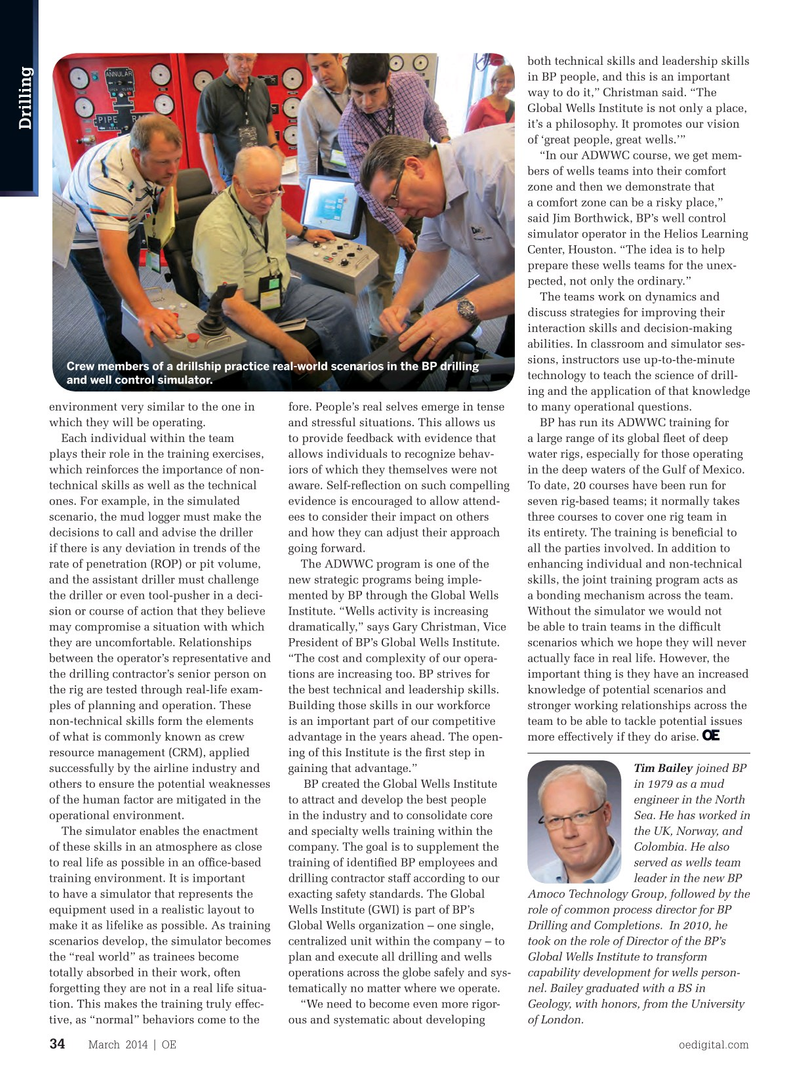
Page 32: of Offshore Engineer Magazine (Mar/Apr 2014)
Read this page in Pdf, Flash or Html5 edition of Mar/Apr 2014 Offshore Engineer Magazine
both technical skills and leadership skills in BP people, and this is an important way to do it,” Christman said. “The
Global Wells Institute is not only a place, it’s a philosophy. It promotes our vision
Drilling of ‘great people, great wells.’” “In our ADWWC course, we get mem- bers of wells teams into their comfort zone and then we demonstrate that a comfort zone can be a risky place,” said Jim Borthwick, BP’s well control simulator operator in the Helios Learning
Center, Houston. “The idea is to help prepare these wells teams for the unex- pected, not only the ordinary.”
The teams work on dynamics and discuss strategies for improving their interaction skills and decision-making abilities. In classroom and simulator ses- sions, instructors use up-to-the-minute
Crew members of a drillship practice real-world scenarios in the BP drilling technology to teach the science of drill- and well control simulator. ing and the application of that knowledge environment very similar to the one in fore. People’s real selves emerge in tense to many operational questions. which they will be operating. and stressful situations. This allows us BP has run its ADWWC training for
Each individual within the team to provide feedback with evidence that a large range of its global ? eet of deep plays their role in the training exercises, allows individuals to recognize behav- water rigs, especially for those operating which reinforces the importance of non- iors of which they themselves were not in the deep waters of the Gulf of Mexico. technical skills as well as the technical aware. Self-re? ection on such compelling To date, 20 courses have been run for ones. For example, in the simulated evidence is encouraged to allow attend- seven rig-based teams; it normally takes scenario, the mud logger must make the ees to consider their impact on others three courses to cover one rig team in decisions to call and advise the driller and how they can adjust their approach its entirety. The training is bene? cial to if there is any deviation in trends of the going forward. all the parties involved. In addition to rate of penetration (ROP) or pit volume, The ADWWC program is one of the enhancing individual and non-technical and the assistant driller must challenge new strategic programs being imple- skills, the joint training program acts as the driller or even tool-pusher in a deci- mented by BP through the Global Wells a bonding mechanism across the team. sion or course of action that they believe Institute. “Wells activity is increasing Without the simulator we would not may compromise a situation with which dramatically,” says Gary Christman, Vice be able to train teams in the dif? cult they are uncomfortable. Relationships President of BP’s Global Wells Institute. scenarios which we hope they will never between the operator’s representative and “The cost and complexity of our opera- actually face in real life. However, the the drilling contractor’s senior person on tions are increasing too. BP strives for important thing is they have an increased the rig are tested through real-life exam- the best technical and leadership skills. knowledge of potential scenarios and ples of planning and operation. These Building those skills in our workforce stronger working relationships across the non-technical skills form the elements is an important part of our competitive team to be able to tackle potential issues of what is commonly known as crew advantage in the years ahead. The open- more effectively if they do arise. resource management (CRM), applied ing of this Institute is the ? rst step in successfully by the airline industry and gaining that advantage.” Tim Bailey joined BP others to ensure the potential weaknesses BP created the Global Wells Institute in 1979 as a mud of the human factor are mitigated in the to attract and develop the best people engineer in the North operational environment. in the industry and to consolidate core Sea. He has worked in
The simulator enables the enactment and specialty wells training within the the UK, Norway, and of these skills in an atmosphere as close company. The goal is to supplement the Colombia. He also to real life as possible in an of? ce-based training of identi? ed BP employees and served as wells team training environment. It is important drilling contractor staff according to our leader in the new BP to have a simulator that represents the exacting safety standards. The Global Amoco Technology Group, followed by the equipment used in a realistic layout to Wells Institute (GWI) is part of BP’s role of common process director for BP make it as lifelike as possible. As training Global Wells organization – one single, Drilling and Completions. In 2010, he scenarios develop, the simulator becomes centralized unit within the company – to took on the role of Director of the BP’s the “real world” as trainees become plan and execute all drilling and wells Global Wells Institute to transform totally absorbed in their work, often operations across the globe safely and sys- capability development for wells person- forgetting they are not in a real life situa- tematically no matter where we operate. nel. Bailey graduated with a BS in tion. This makes the training truly effec- “We need to become even more rigor- Geology, with honors, from the University tive, as “normal” behaviors come to the ous and systematic about developing of London.
March 2014 | OE oedigital.com 34 032_OE0314_DC-2_BP.indd 34 2/21/14 12:26 PM

 31
31

 33
33